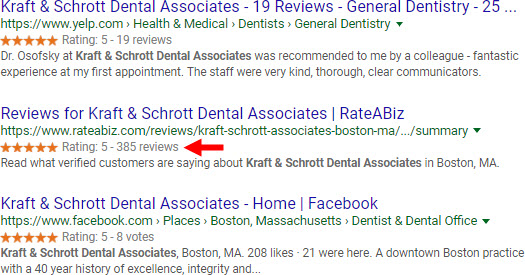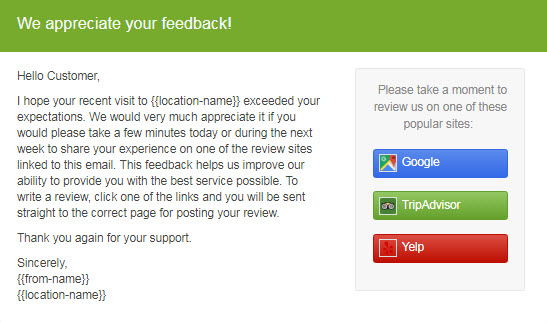It’s tempting to sign up for a “reputation-management” or “review-generation” product and let it pester all your customers for a review – so you don’t have to take the time (or forget) to do it personally.
Resist the temptation. At least until you’ve worked out more manually a review-encouragement strategy that works OK. Otherwise all you’ll do is automate failure.
My advice might be different if review-encouragement software was a surefire way to get you 80% of the great reviews you could get with a more-hands-on method, but with only 20% of the time and effort. But in my experience it doesn’t do that, at least right out of the box. (If you’ve worked out a method that works well without the software, maybe you can get to that 80/20 payoff zone.)
A mediocre-to-OK review strategy is simple to execute: just “do a good job” and ask customers to review you if they’re happy, and contact you first if they’re not. Where it gets trickier is if you want more than just a trickle of reviews, and on sites that really matter.

Most automated review-encouragement programs clear only the lower bar. They require only you to upload people’s email addresses, customize the email that goes out automatically, maybe tweak some settings, and keep a credit card on-file. A great review strategy – one that gets the greatest number of happy customers to write the best reviews they can – takes a little more than that.
I don’t want to name specific products, if I can avoid it. But maybe it’s better that way, because there are a million tools that claim to be your one-stop reviews solution. It’s likely you’ve used or considered at least one such tool, or you probably wouldn’t be reading this.
Some are near-useless, in that most of the “reviews” are in fact testimonials that just molder on the software company’s site (e.g. Demandforce.com), rather than reviews on Google Maps or Yelp or Facebook or Angie’s List or other sites people notice and maybe care about. I’m not even talking about that kind of service here. Rather, I want to give cautionary advice about programs that actually try to encourage reviews on third-party review sites. Seldom are they as effective as you and I would like.
“But Phil, the Big Ugly Corporation I just bought a new refrigerator from just sent me an auto-email to ask for a review, and they have hundreds of reviews from customers. It seems to work fine for them!”
Maybe, but Big Ugly Corporation also has tens of thousands of customers more than you have – and many more opportunities to waste in asking for reviews ineffectively. 200 reviews? That’s still an awful batting average. If you want to do a little better than 1 for 20, you can’t simply rely on a program.
Why? Here are the biggest problems with review-encouragement software:
- If your email or overall strategy isn’t battle-tested, you may burn through all your customers and have little to show for it. What if your review-management software sounds out all the emails – just as it should – and you don’t get any reviews? Maybe everyone ignores the email, or it goes out at a bad hour, or the links are broken, or there are customer-service issues to sort out first. You can ask everyone another time, but after that you become a nuisance. Don’t entrust software with the goodwill you’ve taken years to earn. Put it through a few bird-strike tests first.
- You can’t personalize an automated request to a reviewer’s unique situation. Long-time customer? Super happy customer? Did he have privacy concerns? Is she an “Elite” Yelper? A one-size-fits-all email won’t acknowledge specifics, and probably won’t accomplish all it could.
- The auto-email will seem cold if it’s the first or only time you ask for a review. The recipient will wonder, “Gee, I was just in your office – why didn’t you ask me then?” Ask in-person first, if possible. At least plant the seed of the idea, get a sense of who’s happy (and who’s not), and maybe get a tacit “yes.” That way, even an auto-email won’t seem to come out of the blue, and any follow-up is more likely to work.
- It’s harder to sniff out who’s unhappy. The auto-email will go to everyone, or to large groups of people at a time.
- Weak writing may undo you. Think of how you’d ask a customer, client, or patient face-to-face for a review. Is that how you’d write your automated email? Probably not. In-person you’d care about the timing, and be polite, but also get to the point. In an email you’re more likely sound stuffy or generic, or to beat around the bush. Most people are better writers when they speak than when they write. Too many business owners use automated outreach tools precisely because they don’t want to ask for reviews in-person. Often I find that’s because they haven’t figured out exactly what or how to ask. First figure out how you’d articulate an in-person request, write the email like that, see how it performs, and then automate it if you must. Not the other way around.

- Your auto-email won’t acknowledge people who already reviewed you. That will irk them, and you’ll miss the opportunity to ask, “We’re so crazy about the great review you left us on Review Site A that I’ve just got to ask: could you also review us on Review Site B?”
- Timing may be trickier. You have a sense of what are good times and bad times to ask customers/clients/patients for a review. Outreach software only gives you so much control over when the requests go out.
- Follow-up may be trickier. What if you want to send a follow-up email to some customers after a week, and to other customers after three weeks? Or if they contact you with customer-service issues to sort out, will your program still email them a second time – before you’ve worked out the issue? Maybe you end up choosing not to use the program’s follow-up feature, but if you do use it, it’ll probably complicate your job.
- It’s harder to approach touchy situations. People with privacy concerns you might want to direct to anonymous review sites. Others may be willing to write you a great review, but would want to keep it vague. Some people may not make ideal reviewers after all. And so on. You’re nimbler than the program is.
- You’ll probably treat it as a one-stop solution. The makers of the software market it as such. They’ll tell you that all you need to do is flick it on and watch the reviews whoosh in. You hope that’s how it works out, so you give it a try and don’t bother to do the other things you need to do (e.g. ask customers in-person first).
- You’ll probably treat it as a “set it and forget it” solution. You chose the outreach tool because it’s easy. How likely are you to go in often and update the infernal thing?
- It’s a missed opportunity to learn more about your would-be reviewers. You have to think about, customize, write, and send 100 emails in a month? Yeah, that’s work. But what a great way to interact with and get to know your customers. What a missed opportunity if you don’t bother.
- You miss out on the satisfaction of asking for reviews and getting great ones – or of dodging bullets to your reputation

So review-encouragement software isn’t a surefire way to rack up 5-star reviews. What do I suggest you do instead?
Do MANUAL email outreach, at least for a while. One email at a time. One person at a time.
Try a simple process that works for you, even if takes more time or effort than you’d like. Tweak it as needed until it works pretty well. Then try to make it easier if you want.
At that point, automated review-encouragement software might actually help. You might try Whitespark’s Reputation Builder, or GetFiveStars, or Grade.us, for example. Whatever you use, hold it to high standards. Make sure it brings in almost as many good reviews as you can do with your finest hands-on outreach effort. Continue to ask in-person first (if possible), and send some requests personally every now and then, and always try new things that you might work into the program you use.
What’s worked for you? What hasn’t worked? Leave a comment!


Stellar insights and advice as always Phil. Thank you very much! Very timely as I’ve been considering the benefits of automating elements of the reviews strategies we recommend to clients, and some of the big software players do look great. But I’ll very much heed your wise words as I figure it all out.
Thanks, Geoff.
I’m ok with the streamlined click-in-email review requests that the ecommerce stores send out, given that these are generally for product reviews.
But for local services I totally agree, a personal request either at the time, or via email later is far more congruent, and far more likely to generate the desired result.
I agree, Frank. All these services tout the “full control” they give over your reputation, which I guess is good in theory, but where local businesses need reviews is on sites they can’t control.
In order to keep my costs to a bare minimum, I’ve been using the Repman plugin from Code Canyon. It’s only $19 or $20 and works in a similar manner to the subscription versions you suggested. The developer says he supports it, but I never got a reply to my email. It’s pretty simple, so I don’t think upgrades will be needed.
Thanks, Art. Looks possibly useful. I’d hope that the “send me my gift card” call-to-action is customizable or removable.
The text, title, gift card, star ratings, etc. can be changed. 3 stars or less on one or more questions goes to a sorry about that page. 4 or 5 stars goes to a page of one or more links for reviews on Google My Business, Facebook….anywhere.
Not bad.
Great post Phil! Your post hit home for me–compelled me to add my two cents. I am a dental hygienist who provides dental marketing consulting services including reputation management for dentists/practices. For TWO LONG YEARS, I feel like I have been pulling teeth trying hard to encourage and support dental team members to ask for reviews. You asked for us to chime in….chiming in I am.
I started the team with an instruction sheet for how to leave us a review (your handout you offered previously). Team members were extremely uncomfortable requesting patients to take time to provide feedback. Results: nada one! That idea ended.
Next we tried, signage throughout the office (no verbiage) encouraging people to review us online at either Google, Yelp, Facebook, or Angie’s List. Results: a slight trickle. Signs remain posted today.
Next we tried, a followup survey with a feedback question from Solutionreach (similar to Demandforce). Bingo! On average, we received 30 reviews/month. Results: Fair-ok, but not on the high value, third party sites that help increase brand awareness and local SEO efforts. Results: We quit sending surveys.
Next we tried manually sending invitation links with a verbal request by a few team members who were not afraid to ask. Results: a TINY handful.
Currently: we implemented an automated service in mid August. Results: Just under 40 reviews across Google, Facebook, Angie’s List, and a couple on Yelp in under 14 days! The dashboard shows that approximately 12% of patients have responded to date. Month 2 to date: So far this month, this office has 41 new reviews-mostly on Google and Facebook.
The dentist and team are VERY HAPPY!!!!! We’ll see if the number of reviews moving forward is consistent. We know that it is not as personable, but it is better than SILENCE. Another great post Phil!!!!
Nice job of sticking with it, Michelle. Some clients are gung-ho to ask for reviews. With others it’s an “eat your spinach” proposition.
In the case you describe, one of my concerns would be that most of the reviews in that big wave are from long-time patients. People who’ve been 5-star reviewers in the making for years. Time will tell how the automated service does with newer patients, but at that point maybe all your client wants is a trickle of new reviews.
One thought: now might be a good time to prod them again to ask patients in-person. Now that your client has “seen the light” and knows good reviews are within reach. By now you’ve got more buy-in than you had at first.
Hey Phil, good points as usual. I agree with most. But I also think you missed pointing out that although there are lots of services that claim to help, not all are created equal. Just like professional SEO help like yourself, there are good ones and there are not good ones. The services you mention directly are the ones that suffer the most from your complaints – not turn key, not personal, too many choices, doomed to fail without extra work. Companies like mine, Broadly, help to solve those pain points — and we come with a lot of experience from Demandforce YP, Intuit, and others. Perhaps this is part of your own business model — tools that require extra help that you can provide. I think your post would be more complete by pointing out the differences between more full service tools and more self service tools (that then often require paying someone else to help manage or they are a meat grinder). That could help local business owners make the most informed decision on what areas to spend their hard earned dollars on.
I see your point, Josh. Mine is pretty simple: if you don’t yet know what works, a “turn-key,” automated solution often will do more harm than good. That’s true of your software and of all others, no matter how many “pain points” you might have anticipated, because people can always use a good tool poorly.
The point of my post was not to tell the reader, “Use these ‘incomplete’ services so you can hire me to help you complete them.” I simply don’t want the reader to sign up for a service blindly and expect it to work right away. Please refer back to my “bird-strike test” metaphor.
I guess I would say we are more “opinionated” than most and hence try to not allow things that would cause the harm your referring to. Do we allow you to spam your customers? No, just better communicate. Do we allow you to edit where the reviews go? No, it’s about the consumer’s sentiment, not the business’s. Do we allow various bulk operations? No, go use a traditional email tool. Do we allow any customization? Almost none. Why? To exactly your point. Not to be boastful, but in your same vein, we help you do it right. Trust us and we are happy to show you data or details to back it up. When we say “Automatic”, we mean it. If you want customization, go hire someone or use a self-serve tool. We believe the bulk of business owners want automatic, exactly why you warn of it in the post.
That’s good to hear, Josh. I’m sure your product is just what the doctor ordered in many cases.
Great post, Phil! I agree. Although we still have a long way to go with getting more reviews, we’ve found training our managers to always be asking for reviews, especially in-person, has been more effective at getting us reviews than the review-encouragement software we tried which we hoped would be a silver bullet.
Thanks, Matt. Yeah, if I had to pick just one, I’d go with in-person requests. Sounds like you guys do it well. But doing in-person plus follow-up by email is usually the most effective, at least in my experience.
Thanks for mentioning the Whitespark Reputation Builder, Phil. I appreciate and agree with a lot of the points you mention here. If the goal is to get more reviews, and the business has time, or will make time, to do the personal ask, then that will definitely be the most effective way to get more reviews. This falls apart when you’re dealing with a business owner that just won’t make the time, though, and sending review asks through an automated platform is certainly a lot better than sending no review asks at all. I remember when you and I ran our LocalSpark agency together, and one of the monthly tasks we’d assign to the project managers was “review nagging”! Haha. 🙂
Besides the boost in reviews, I think there are other benefits to review platforms that make them worth the reasonable monthly fees:
– The feedback funnel where happy customers are sent to review sites and unhappy customers are sent to a feedback form.
– Collecting positive feedback to embed on your own website as schema marked up testimonials (a high percentage of the happy customers tend to leave direct feedback rather than go to the review sites)
– The negative feedback collected (internally instead of on the review sites) is a treasure trove of information you can use to improve your business.
– Collecting aggregate data from your customer base on the NPS score (a good metric to gauge how your business is doing overall)
– Review monitoring and alerting
– For businesses with high customer volume (imagine a retail store), sending customized manual review asks is impossible, so the automated system is a godsend.
– For multi-location business it’s amazing to get comparative customer satisfaction reporting across all the locations.
If you’re a single location business and have the time to send personalized review asks to all your customers, then yes, this will result in more online reviews. For businesses that can’t do that, the automated systems are a huge help, and they come with all these other benefits too!
Hey man,
I agree that in some cases – like the one you describe – some outreach (even if it’s a bit ham-handed) is usually better than doing nothing. Maybe it just depends on whether the customers are mostly happy. If they are, then the business probably benefits in the ways you point out. If not, the outreach software makes it even more a game of reputation roulette.
Anyway, great points.
Phil: Great article, thoughtful commentary, and it struck a nerve. I see a lot of comments in a short time; thoughtful comments.
I appreciated the intro and your suggestions about how to tackle this situation and some of the concrete suggestions. The business in my sig has been riding a high with reviews for some time. Its a service and the nature of the service and the way we deliver it gives us some advantages in garnering reviews directly. Some of those advantages though are reflected in your comments. We think various SMB’s can incorporate them.
While you suggest a business and the owner make a concerted effort to go after and get reviews that show in the places “that matter” such as Google, Yelp, FB, Angie’s list, etc. Darren notes that if an owner doesn’t make that effort an automated response might get you those important, and hopefully great reviews anyway.
Our experience is that to get them, one has to make that effort from the top, train staff and get buy in from your staff to appropriately ask for reviews. If so you will get results that reflect the nature of the smb and its products and customer service.
We say that b/c we have and do run a number of smb’s with partners of the type in my sig. Not all are great in accumulating reviews and positive reviews. Same service, same objective, wildly different results. The facts are that if we don’t have complete buy in at the top of the on site business it doesn’t work well. We have other totally different SMB’s. Very different services, but a similar ability to get close and interactive with customers. Generally the staff is trained and buys in to the review management (asking for reviews) process, the service is great and the reviews reflect all that.
Different businesses face different hurdles in obtaining reviews, and possibly even a greater difference in interacting with customers in a way that might enable the businesses to ask for and get reviews by personal contact.
Michelle Nun’s great comments above highlight that. The differences between the environment in dental offices and bartending schools is profound. In any medical office the docs themselves might be zooming through customer interactions/ treatment and simply can’t afford the time to be chummy with patients. More patients await. Then it becomes incumbent upon the staff to provide those ancillary services that make the visit that much more pleasant, satisfying and customer friendly.
That is where the top person has to step in, train the staff, and develop that atmosphere that augments hopefully great treatment at the Doc level, and supports it with great service at the staff level AND AND AND gets to ask for reviews on a more personal and direct level.
(this is a longish response)
Because of the nature of the bar school business and the placement services we offer that involve a lot of direct interaction with restaurants/bars/employers we get to see a type of business where customer service is hopefully emphasized and is commented upon and reflected in reviews ENDLESSLY. Absolutely great customer service is commented upon in restaurant reviews ALL THE TIME, and lousy service is similarly commented upon with poor review ratings.
Restaurants may or may not have great training programs. Then it depends on the individuals and management staff to see how it is implemented. From the customer side or review reader side if you see a server/bartender’s name mentioned repeated with regard to great service, then you know someone has taken that customer service level seriously and applies that well.
Owners, decision makers, operators should be training staff and looking for that level of service in staff. When you find it, get them to ask for reviews. It will work like a charm.
Well-said, Dave.
I’d add to the “some outreach is better than none” line of discussion only that some business owners are deadbeats, and shoot themselves in the foot. Yes, nobody has much time, and it’s hard to get the rank-and-file motivated, and it’s all easier said than done. No argument there. But that’s why – as I think we’d all agree – it’s smart to use an outreach program if and when you have at least a rough idea of what works. But to make a gun standard-issue for a whole army before confirming that it goes boom? Madness.
Most business owners will need to figure that one out eventually – often under less-voluntary circumstances, like when a really unhappy customer comes out swinging. It’s a shame when it comes to that, but at least it usually motivates people to figure out what gets the happy customers to weigh in.
Now: Bottom line on lots of high ranking reviews is that it results in sales. With the smb in my sig we get to do marketing surveys of a pretty large number of customers: (several thousand customers)
Some relevant Takeaways:
1. 2 biggest sources of leads (by far). Search and a combo of WOM/Direct Referrals
2. Of customers who found us in search: biggest reasons for choosing us: Well there are a lot of factors, but among them and at the top–> High Volume and High Ranking Reviews.
(Interestingly, and it makes sense: Direct referrals who purchased either NEVER or virtually never mention web reviews as a source for buying)
So we make good $$$ from having both a high volume of reviews and more importantly very high ratings. The reviews read real and varied and they are real. It comes across.
BTW: We have testimonials on the site: and sites with good reviews/ratings that don’t get seen (something akin to demandforce). None of our customers have EVER referenced testimonials on the site or those less visible/important websites as a reason for Buying–
Our real world experience agrees with your analysis, Phil.
I can see that, Dave. Sure sounds like you guys have covered the bases.
Of course, reviews also help with those WOM referrals. I’d guess most of those people Google you at some point. Then the reviews either seal the deal or make them consider getting new friends 🙂
Correctomundo Phil:I forgot to mention that. Many of the WOM leads are simultaneously Search leads. In those cases the review ratings and large volume of reviews DO seal the deal.
But it really is striking. W/ a sample size of several thousand customers, not one ever mentioned testimonials on the site as a reason to buy.
Yeah. Though testimonials have their place in the world, they usually do come across as a compliment from mom.
Phill.
I had a painful experience with my reputation management company. Not only did I pay up front it NEVER WORKED. In fact, it only angered the few I had the emails sent to. I am a private investigator and I knew it would be tricky to ask most clients for a review, so I hired a company that allowed me to “customize” the emails. In a few short months, I created more work for myself, and cost myself 2,000 dollars.
I should have simply followed your standing advice and sent a few people a “test” email and THEN send them your instructions on how to leave a review. Needless to say, that is what I do now. If I get positive results from a client, I ask them right then for a review. If I felt I had missed that opportunity, I’ll email them shortly after the dust has settled.
Thanks for the great posts!
Ken Childs
Ouch. That’s often how it goes down, from what I’ve seen. It always becomes a question of, “What do we do now?”
Sounds like you’ve got a great system now
Thanks for the insights, Phil. Your share a much needed perspective.
While good reviews are the currency of an online reputation, what I’d really like to see are clients soliciting feedback to learn what they’re doing well, failing at, etc…then reviewing their own procedures. All of us tend to brush off the complainers – some are true nut jobs, but even then there is usually an element of truth, as painful as it might be. Wish we could shift the focus from racking up stars to growth through fundamental change.
I’m with you, Janet. Mystery-shopping by phone can be extremely valuable. (Or putting on Groucho Marx glasses and visiting your business as a “new customer.”)
Phil,
Thanks for the mention of Grade.us–and for the reality check! Your comments are, as always, on point. You speak truth to hype. But gee, I hope serious solution providers don’t market our solutions as “flick it on and watch the reviews whoosh in”! What worth doing is ever that easy?
As for Grade.us, we’ve found our “sweet spot” putting our review management software in the hands of smart consultants, agencies, and brands who bring to the table the wherewithal and effort you describe here–in fact, many of them probably read your blog 😉
And even when they can’t do everything you describe here, all of the value points Darren mentions still come into play with review management software: reaching unhappy customers before they bad-mouth your business online, automated SEO-friendly content for your website and social media, review monitoring and alerting, a database of customer feedback and market intelligence, etc.
Of course I agree with your caution about missing the opportunity to maximize outcomes or having unreal expectations of software. But it’s also true that software is relatively cheap and effective, and time is precious. Those businesses who use the software actively and intelligently probably win the biggest.
Jon
Sure thing, Jon. You put together a good product in a circumspect way.
Great piece. Agree with many of your points and some of those made in the comments. I would like to add that having video reviews/testimonials is another way to “stick out from the crowd” with reviews and make a more genuine presentation of your review collection. Video reviews capture the customer’s comments and at the same time their emotions about your product or service. They can be captured while the customer is in front of you or via an email. A good mix of text and video testimonials will enhance your review strategy.
As a full disclosure, I am the co-founder of VocalReferences – a video review recording tool.